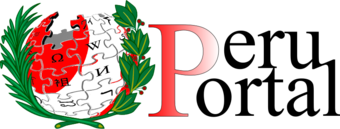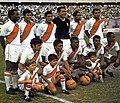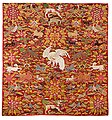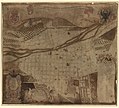
A | B | C | D | E | F | G | H | CH | I | J | K | L | M | N | O | P | Q | R | S | T | U | V | W | X | Y | Z | 0 | 1 | 2 | 3 | 4 | 5 | 6 | 7 | 8 | 9
Introduction
Peru, officially the Republic of Peru, is a country in western South America. It is bordered in the north by Ecuador and Colombia, in the east by Brazil, in the southeast by Bolivia, in the south by Chile, and in the south and west by the Pacific Ocean. Peru is a megadiverse country with habitats ranging from the arid plains of the Pacific coastal region in the west to the peaks of the Andes mountains extending from the north to the southeast of the country to the tropical Amazon basin rainforest in the east with the Amazon River. Peru has a population of over 32 million, and its capital and largest city is Lima. At 1,285,216 km2 (496,225 sq mi), Peru is the 19th largest country in the world, and the third largest in South America. Peruvian territory was home to several cultures during the ancient and medieval periods, and has one of the longest histories of civilization of any country, tracing its heritage back to the 10th millennium BCE. Notable pre-colonial cultures and civilizations include the Caral–Supe civilization (the earliest civilization in the Americas and considered one of the cradles of civilization), the Nazca culture, the Wari and Tiwanaku empires, the Kingdom of Cusco, and the Inca Empire, the largest known state in the pre-Columbian Americas. The Spanish Empire conquered the region in the 16th century and Charles V established a viceroyalty with the official name of the Kingdom of Peru that encompassed most of its South American territories, with its capital in Lima. Higher education started in the Americas with the official establishment of the National University of San Marcos in Lima in 1551. Peru's population includes Mestizos, Amerindians, Europeans, Africans and Asians. The main spoken language is Spanish, although a significant number of Peruvians speak Quechuan languages, Aymara, or other Indigenous languages. This mixture of cultural traditions has resulted in a wide diversity of expressions in fields such as art, cuisine, literature, and music. (Full article...) Entries here consist of Good and Featured articles, which meet a core set of high editorial standards.
Purupuruni is a group of lava domes in southern Peru and a correlative geological formation. They are among the many volcanoes that exist in Peru and whose activity has been associated with the subduction of the Nazca Plate beneath the South America Plate. Purupuruni is associated with a geothermal field and a caldera. Volcanic activity occurred during the Pleistocene 53,000 ± 8,000 years ago but also during the Holocene about 5,300 ± 1,100 years ago; today the volcano is considered to be a low hazard volcano but is being monitored nevertheless. (Full article...) Selected image Photo credit: And2000
The Palace of Justice (Spanish: Palacio de Justicia) is the seat of the Supreme Court of Peru. It is located in the Lima District of the city of Lima, capital of Peru. Construction started during the second government of Augusto B. Leguía (1919–1930) and finished under the presidency of Óscar R. Benavides, who inaugurated the building in 1938. The Palace was built in a neoclassical style as its plans were based on those of the Law Courts of Brussels, Belgium. However, it lacks the dome of its Belgian counterpart and it is much smaller. (more...) Selected battleThe Battle of Arica, also known as Assault and capture of Arica Cape, is a belic action of the War of the Pacific. It was fought on June 7, 1880, between forces of Chile and Peru. After the Battle of Tacna, and the following Bolivian retirement of the war, Peru had to stand alone for the rest of the conflict. The need of a port near to the location of the army, in order to supply and reinforce the troops and the evacuation of the wounded, made the Chilean command to put its attention on the remaining Peruvian stronghold in the Tacna Department. Thus, a fraction of the Chilean army, led by Colonel Pedro Lagos, launched a simultaneous assault from both sides, taking the defenses on a bayonet charge, and captured the Morro de Arica (English: Arica Cape) from the defending Peruvian troops under the command of Colonel Francisco Bolognesi in a last attack up the hill. In this fight the Peruvian Commander died along with several officers and more than 1.000 men. (more...) In this month
General imagesThe following are images from various Peru-related articles on Wikipedia.
Selected article -The Spanish conquest of the Inca Empire, also known as the Conquest of Peru, was one of the most important campaigns in the Spanish colonization of the Americas. After years of preliminary exploration and military skirmishes, 168 Spanish soldiers under conquistador Francisco Pizarro, along with his brothers in arms and their indigenous allies, captured the Sapa Inca Atahualpa in the 1532 Battle of Cajamarca. It was the first step in a long campaign that took decades of fighting but ended in Spanish victory in 1572 and colonization of the region as the Viceroyalty of Peru. The conquest of the Inca Empire (called "Tahuantinsuyu" or "Tawantinsuyu" in Quechua, meaning "Realm of the Four Parts"), led to spin-off campaigns into present-day Chile and Colombia, as well as expeditions to the Amazon Basin and surrounding rainforest. When the Spanish arrived at the borders of the Inca Empire in 1528, it spanned a considerable area and was by far the largest of the four grand pre-Columbian civilizations. Extending southward from the Ancomayo, which is now known as the Patía River, in southern present-day Colombia to the Maule River in what would later be known as Chile, and eastward from the Pacific Ocean to the edge of the Amazonian jungles, it covered some of the most mountainous terrains on Earth. In less than a century, the Inca had expanded their empire from about 400,000 km2 (150,000 sq mi) in 1448 to 1,800,000 km2 (690,000 sq mi) in 1528, just before the arrival of the Spanish. This vast area of land varied greatly in culture and climate. Because of the diverse cultures and geography, the Inca allowed many areas of the empire to be governed under the control of local leaders, who were watched and monitored by Inca officials. Under the administrative mechanisms established by the Inca, all parts of the empire answered to, and were ultimately under the direct control of, the Inca Emperor. Scholars estimate that the population of the Inca Empire was more than 16,000,000. (Full article...)Did you know (auto-generated) -
CategoriesRelated portalsSelected quote -
Basic facts & figuresMore did you know...
Peru TopicsRecognized content
Featured articlesFeatured listsGood articles
WikiProjectsThings you can do
New articlesThis list was generated from these rules. Questions and feedback are always welcome! The search is being run daily with the most recent ~14 days of results. Note: Some articles may not be relevant to this project.
Rules | Match log | Results page (for watching) | Last updated: 2024-06-19 21:34 (UTC) Note: The list display can now be customized by each user. See List display personalization for details.
Associated WikimediaThe following Wikimedia Foundation sister projects provide more on this subject:
Discover Wikipedia using portals | ||||||||||||||||||
Text je dostupný za podmienok Creative Commons Attribution/Share-Alike License 3.0 Unported; prípadne za ďalších podmienok. Podrobnejšie informácie nájdete na stránke Podmienky použitia.
Antropológia
Aplikované vedy
Bibliometria
Dejiny vedy
Encyklopédie
Filozofia vedy
Forenzné vedy
Humanitné vedy
Knižničná veda
Kryogenika
Kryptológia
Kulturológia
Literárna veda
Medzidisciplinárne oblasti
Metódy kvantitatívnej analýzy
Metavedy
Metodika
Text je dostupný za podmienok Creative
Commons Attribution/Share-Alike License 3.0 Unported; prípadne za ďalších
podmienok.
Podrobnejšie informácie nájdete na stránke Podmienky
použitia.
www.astronomia.sk | www.biologia.sk | www.botanika.sk | www.dejiny.sk | www.economy.sk | www.elektrotechnika.sk | www.estetika.sk | www.farmakologia.sk | www.filozofia.sk | Fyzika | www.futurologia.sk | www.genetika.sk | www.chemia.sk | www.lingvistika.sk | www.politologia.sk | www.psychologia.sk | www.sexuologia.sk | www.sociologia.sk | www.veda.sk I www.zoologia.sk


















































